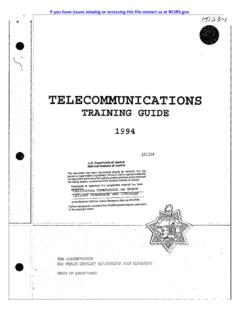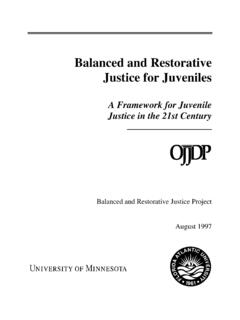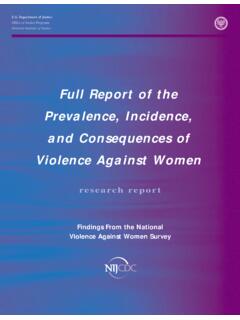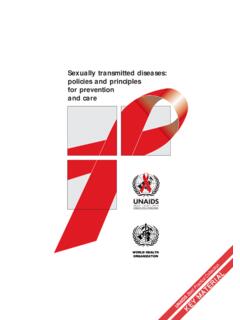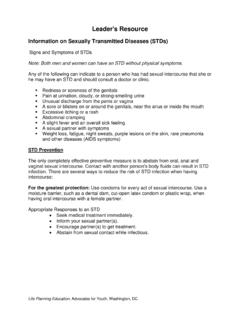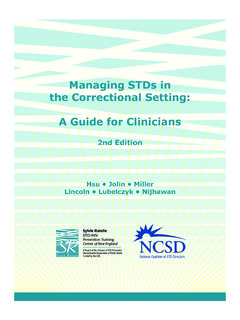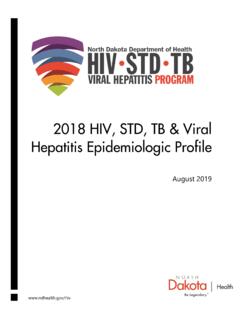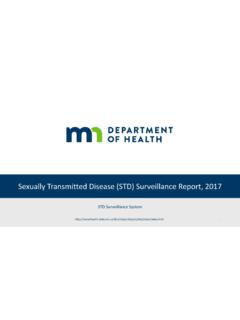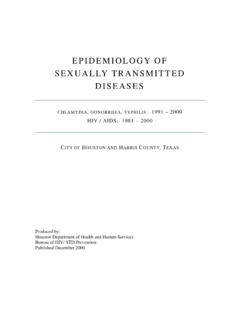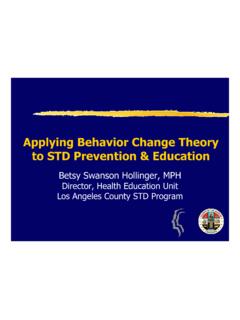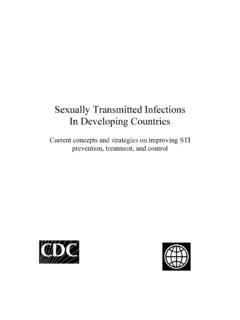Transcription of Sexually Transmitted Diseases and Child Sexual Abuse
1 Department of JusticeOffice of Justice ProgramsOffice of Juvenile Justice and Delinquency PreventionPortable Guides toInvestigating Child AbuseSexuallyTransmittedDiseasesand ChildSexual AbuseForewordInvestigating allegations of Sexual Abuse of children is verydifficult for law enforcement. Successful resolution of thesecases is often hampered by victim reluctance or inability tocommunicate as well as the scarcity of corroborating the consequences of all Abuse of children are of greatconcern to us, Sexual Abuse can be particularly devastating,especially when a Sexually Transmitted disease is part of thetragic legacy of guide is designed to present additional investigativetechniques, utilizing the presence of a Sexually transmitteddisease, which will assist in identifying or eliminating suspectsin Sexual Abuse cases. Successful investigations are crucialbecause they can be the gateway to treatment for victims andcan help protect them from further victimization.
2 The guidealso seeks to sensitize investigators to the need for personalprecautions when investigating these cases and helps them torecognize children in need of immediate medical is proud of this offering and urges you to make useof it as we work to protect our Printing June 1996 Second Printing July 1997 Third Printing March 2001 Fourth Printing December 2002 NCJ 1609401 Sexually Transmitted Diseases (STD s) comprisea wide range of infections and conditions thatare Transmitted mainly by Sexual activity. Theclassic STD s, gonorrhea andsyphilis, are now beingovershadowed by a newset of STD s that are notonly more common, butare also more difficultto diagnose and new STD s includeinfections caused by Chlamydiatrachomatis (chlamydia), human papilloma virus(HPV), bacterial vaginosis (BV), and humanimmunodeficiency virus (HIV). Rapid applicationof new technology to the diagnosis of STD s has ledto a growing array of diagnostic laboratory tests thatrequire critical evaluation by clinicians and a criticalreview by law enforcement (see table 1).
3 2 Accurate information about STD s in victims of Sexual abusehas been hindered by a variety of factors: The prevalence of Sexually Transmitted infections may varyregionally and among different populations within the sameregion. Few studies have attempted to differentiate between infectionsexisting prior to Sexual Abuse and those that result from presence of a preexisting infection in adults is usually relatedto prior Sexual activity. In children, however, preexisting infectionsmay be related to prolonged colonization after perinatal acquisition(acquisition immediately before and after birth), inadvertentnonsexual spread, prior peer Sexual activity, or prior Sexual Abuse . The incubation periods for STD s range from a few days forgonorrhea to several months for HPV. The incubation periods andthe timing of an examination after an episode of Abuse are criticallyimportant in detecting infections (see table 1).
4 When presented with a Child with an STD,law enforcement officials must attempt todetermine absolutely if the infection wasassociated with Sexual contact and, forthe purposes of prosecution, whetherappropriate diagnostic methods wereused. The following facts should be keptin mind: STD s may be Transmitted during Sexual assault. Multiple episodes of Abuse increase the risk of STD infection,probably by increasing the number of contacts with an infectedindividual, and rates of infection also vary by the type of example, vaginal or rectal penetration is more likely to leadto detectable STD infection than fondling. Sexual assault is a violent crime that affects children of all ages,including infants. The majority of children who are Sexually abused will have nophysical complaints related either to trauma or STD Sexually abused children do not indicate that they havegenital pain or problems.
5 In children the isolation of a Sexually Transmitted organism maybe the first indication that Abuse has In most cases, the site of infection is consistent with a Child shistory of assault. Although the presence of a Sexually transmissible agent in achild over the age of 1 month is suggestive of Sexual Abuse ,exceptions do exist. Rectal and genital chlamydia infections inyoung children may be due to a persistent perinatally acquiredinfection, which may last for up to 3 incidence and prevalence of Sexual Abuse in children aredifficult to estimate. Most Sexual Abuse in childhood escapes detection. Patterns of childhood Sexual Abuse appear to depend on the sexand age of the victim. Between 80 and 90 percent of Sexually abused children are female(average age: 7 to 8 years). Between 75 and 85 percent of Sexually abused children wereabused by a male assailant, an adult or minor known to the individual is most likely a family member such as the father,stepfather, mother s boyfriend, or an uncle or other male relative.
6 Victims of unknown assailants tend to be older than childrenwho are Sexually abused by someone they know and are usuallyonly subjected to a single episode of Abuse . Sexual Abuse by family members or acquaintances usuallyinvolves multiple episodes over periods ranging from 1 weekto years. Most victims describe a single type of Sexual activity, but over 20percent have experienced more than one type of forced Sexual penetration has been reported to occur in approximatelyone-half and anal penetration in one-third of female victims ofsexual Abuse . Over 50 percent of male victims of Sexual Abuse have experiencedanal penetration. Other types of Sexual activity, including oral-genital contact andfondling, occur in 20 to 50 percent of victims of Sexual Abuse . Children who are Sexually abused by known assailants usuallyexperience less physical trauma, including genital trauma, thanvictims of assaults by strangers because such trauma might arousesuspicion that Abuse is andIncubationClinicalTransmissionDiagnos isOrganism(s)PeriodManifestations1.
7 Culture of N. gonorrhoeaeusing selective mediawith confirmation byat least two differentmethods using differentprinciples, , sugarfermentation, enzymesubstances, serologicalor DNA Use of DNA probesor other nonculturemethods, includingGram-stained smearsor vaginal or urethraldischarges, is notrecommended becauseGonorrheaNeisseriagonorrhoeae3 5 days1. Vaginitis, urethritis,pharyngitis, Rare: Arthritis, Most pharyngeal(throat) and rectalinfections and asmany as 50% ofvaginal infectionsin children maybe Through Exception: Neonatalconjunctivitis isacquired by theinfant from his/hermother at No evidence oftransmission byfomites ( , viatoilet seats, dirty towels, etc.).Table 1 Incubation Periods, Clinical Manifestations, Transmission, and Diagnosis ofSexually Transmitted Diseases (STD s)*5other bacteria maybe misidentified asN. Isolation of the organismin tissue culture onlywith microscopicidentification of thecharacteristic inclusionswith fluorescentantibody Nonculture methods,including enzymeimmunoassays (EIA s),direct fluorescentantibody (DFA) tests,and DNA probes, arenot approved for use inrectal or genital sites inchildren.
8 Use at thesesites has led to manyfalse-positive Sexually , in children 3years of age or Perinatally acquiredinfection (mother-to-infant) may last in thevagina and rectum forup to 3 years or No evidence oftransmission Most prevalent sexuallytransmitted infection inthe United In adults andadolescents: Urethritisand mucopurulentcervicitis, whichcan lead to pelvicinflammatory disease;however, most infectionsin adults and childrenare 7 daysChlamydialinfectionsChlamydiatrachom atis6 STD andIncubationClinicalTransmissionDiagnos isOrganism(s)PeriodManifestations1. Primary syphilis:Chancre, , a painlessulcer at the site ofinoculation (penis, vulva,vagina, rectum, etc.).The chancre healsspontaneously after1 2 Secondary syphilis:Diffuse rash, fever,enlarged lymph nodes,mucous Latent syphilis: Asymp-tomatic, although positiveserological findings maypersist for Through sexualcontact.
9 The chancreand mucous patchesare very Infants may acquirecongenital syphilisfrom their presentation issimilar to Identification ofT. pallidum in lesions bydark-field microscopyor by staining with afluorescein-conjugatedmonoclonal The most commonmethods used areserological: Rapidplasma reagin (RPR)test; Venereal DiseaseResearch Laboratory(VDRL)-reaginicantibody test; andfluorescent treponemalantibody-absorptionTable 1 continued Incubation Periods, Clinical Manifestations, Transmission, and Diagnosis ofSexually Transmitted Diseases (STD s)*SyphilisTreponemapallidum1. Primaryinfection:10 90 days,usually 3 Secondary:6 weeks 6months afterthe primarylesion (FTA ABS) test, atest for a specific anti-T. pallidum Positive results on anRPR or VDRL testin a Child who doesnot have a history ofcongenital RPR and VDRL testresults will be negativeafter effective treatment;FTA ABS remainselevated for the lifetimeof the andIncubationClinicalTransmissionDiagnos isOrganism(s) identificationof the organism invaginal Culture methods maybe more sensitive, butnot widely The finding oftrichomonads in urinecollected for anotherpurpose is not sufficientfor accurate diagnosis,as the urine could becontaminated withT.
10 Hominis, a normalinhabitant of the bowelthat is not 1 continued Incubation Periods, Clinical Manifestations, Transmission, and Diagnosis ofSexually Transmitted Diseases (STD s)*TrichomoniasisTrichomonasvaginalis5 28 days1. In males, infectionappears to beasymptomatic,but T. vaginalis maycause some cases ofnonspecific Through Has not been found inchildren 1 year of ageor older without historyof Sexual Infants can acquireinfection from motherat delivery; can Perinatally acquiredinfection may persistfor 6 9 months No evidence oftransmission Microscopicidentification of clue cells, which areepithelial cells studdedwith bacteria in vaginalsecretions; a positive whiff or amine test,which is the release ofa very characteristicfishy odor when 10%potassium hydroxide(KOH) is added to thevaginal fluid; and avaginal fluid pH of The latter test shouldonly be done inadolescents, as there areno vaginal pH standardsfor prepubertal Culture of G.
